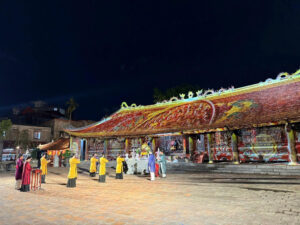Many centuries ago, boats from far off lands such as the Netherlands, Japan and China came to central Vietnam’s Hoi An to trade.
This ancient city, named an official world heritage site by UNESCO, still reflects the openness its local residents to other cultures as evidenced the architecture, food and handmade products of modern day Hoi An.
The silk lantern is one of Hoi An’s most famous handicrafts. The streets are full of people decorating silk lanterns in front of houses, restaurants and shops.
Silk lanterns create a vibrant and elegant atmosphere in homes and gardens. As people are now looking to return to handmade and environmentally friendly products, silk lanterns are good option for interior decoration.
In most of the shops in Hoi An’s old quarter like Tran Phu, Le Loi, Phan Chau Trinh, silk lanterns are sold at very reasonable prices (from US$1 to $30).
“I chose an orange and a red lantern (only $10 for both). I will arrange them on my balcony,” said Ms. Nguyen Thu, a tourist on Chua Cau (Japanese Bridge) Street. The lanterns are flexible, making them easy to transport.
“The best colors for silk lanterns are red, orange, yellow and blue. When they become alit, these colors look best,” said Ms. Chau, a shopkeeper on Chua Cau Street.
In addition to traditional shapes, many silk lanterns are made in the form of lotuses or bird cages. Some (especial white ones) contain imprints of bamboo leaves, flowers or Chinese calligraphy.
In the afternoon when the old quarter becomes free of motorbikes and cars, it is very relaxing to walk and pass by the shops filled with colorful silk lanterns.
This is when silk lantern craftsmen make new products to be sold later. One sees them surrounded by unfinished lanterns on the sidewalk in front of shops.
”A silk lantern is created by many persons through different processes. First, you need to make a bamboo frame for the lantern in the shape you wish. After that another person will complete the shape of the frame with a small string. And then yet another artisan will cut the silk into small pieces to stick to the frame,” said Thuy, a young girl at a lantern shop at the end of Chua Cau Bridge.
“After covering a quarter of the lantern, we have to wait for the glue to dry before continuing on to the next quarter,” said Thuy.
She said it is important to use precisely the right amount of glue so as not to leave stains on the lantern.
Every evening at 6:30 p.m., lanterns on the Hoi An streets light up, casting a mysterious atmosphere over the old quarter, making visitors feel like they are walking through a sweet and peaceful legend.














